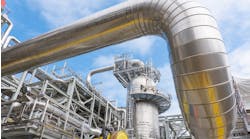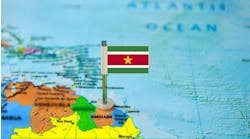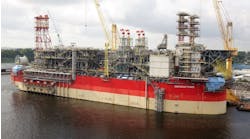WEST AFRICA: TotalFinaElf prepares to launch two further developments in Angola block 17
Jeremy Beckman
Editor, Europe
Higher capacity FPSO for Dalia
Fourteen months after first oil, Angola's "flowers" block 17 continues to blossom. Girassol's wells are flowing beyond expectation, and future subsea tie-ins may warrant lifting the production threshold. Elsewhere in the 400-sq-km concession, the backlog of fields lined up for development has risen to 12, following the recent Zinia discovery.
Girassol was Angola's first truly deepwater development, in depths of up to 1,400 m. The field was discovered in Oligocene layers in April 1996 and swiftly appraised by two productive follow-up wells. Concurrently, exploration drilling at other prospects yielded a near-unbroken chain of finds from Miocene and Oligocene plays. The results persuaded operator TotalFinaElf to press ahead with development of Girassol in July 1998. TotalFinaElf's co-venturers in block 17 are BP, Esso Exploration Angola, Norsk Hydro, and Statoil, with Sonangol as concession holder.
The centerpiece of this $2.8-billion project, 150 km offshore Angola, was at the time the world's largest capacity FPSO, with 200,000 b/d crude processing capability and storage of up to 2 MMbbl. The plan was to pipe the oil via two short export lines to a loading buoy one nautical mile distant. The FPSO and buoy would be moored respectively by 16 and nine suction anchors, each weighing 160 metric tons. The developers envisioned one tanker mooring alongside the buoy every five days for cargo transfer operations.
null
Girassol's reservoir is relatively shallow-lying at 1,200 m below the seabed and has an areal extent of 14 x 10 km. Complications at the outset included unconsolidated sands and the oil's paraffin content. Additionally, the water temperature at the seabed is only 4°C, which in turn would cool oil exiting the wells at around 60°C. This combination would potentially leave the wells and sea lines prone to blockages caused by paraffin deposition and hydrate formation.
TFE's solution was a subsea scheme configured as five loops, comprising 144 km of production line bundles, water and gas injection flowlines, and electric/hydraulic service umbilicals. These would be connected to the FPSO via three 1,250-m-tall riser towers. The bundled risers would be insulated to ensure crude arrived at the vessel at 40°C during normal conditions. A high-performance syntactic foam packed around the riser towers would maintain buoyancy in a vertical position.
The field came onstream with eight producers in December 2001, without serious hitches. Stolt Offshore's Matis deepwater connection system performed largely as planned. This had been viewed as a potential risk, due to the sheer volume of subsea connections. In May 2002, the loading buoy broke free of its mooring system, but the readily available back-up tandem offloading system onboard the FPSO prevented any production losses.
Girassol's original plan was based on 39 subsea wells, comprising 23 producers, 14 water injectors, and two gas injectors. Two dynamically positioned drillships, the Pride Africa and Pride Angola, were hired for the installations on a long-term contract. As events transpired, the 200,000 b/d plateau was scaled by March 2002, with no sign of any fall-off through to Dec-ember, when 17 wells, including 11 producers, were tied in. By the end of this month, 20 wells should be onstream.
Producers have been delivering at rates of up to 35,000 b/d.
"We have been very successful with the well design and subsea completion installation," said block 17 Manager Andre Goffart, "with so far no sand production. Everything's been going very well for us, but it's too early to take a definitive long-term view. Sand can be produced when you start producing water. Otherwise, the reservoir to date is behaving as we expected – very trouble-free, compared, say, to the Gulf of Mexico, where it is normally a lot more difficult to predict performance. Our partners have confirmed this view. Generally, the behavior of deepwater West African reservoirs has been easier to predict. Now that we have acquired a lot of information on Girassol's reservoir, we are trying to optimize recovery from the field."
null
This might mean drilling fewer wells than originally planned, with intelligent completions in multiple layer wells. Later on, infill wells could be added in areas where bypassed oil may be present.
Although TotalFinaElf has referred to a second phase of subsea flowline and manifold installations on Girassol kicking off this year, "for us, this is a continuous drilling program," Goffart said. During the same campaign, the Jasmim subsea facilities will also be installed. This project will involve drilling five producers and five water injectors to produce the C1/C2/C3/C4 Oligocene channels immediately west of Girassol. The wells will be tied back to the existing riser towers through additional production and injection lines, and minor modifications to the FPSO will be made to complete the tie-in of the field this year.
"We expect to stay on plateau until some time in 2005. Then we will start connecting Rosa, the next phase of subsea tiebacks related to our Rosa Lirio field development."
Sanction for this project is targeted for mid-year. Provisionally, the plan involves extending the Girassol FPSO's process capacity to around 250,000 b/d to cope with extra production from Rosa Lirio. This would be achieved mostly through upgrading the water treatment and injection facilities.
"Our main objective is to make sure we produce all our block 17 resources in optimum condition," Goffart said. "Considering the good reservoir behavior, we have engaged in discussions with Sonangol on options to increase offtake."
The Rosa reservoir is composed of two culminations, called Rosa D and Rosa E, discovered in 1998 by two wells. It will be developed through 28 wells, including water injection. The Lirio and the Cravo reservoirs were discovered by dedicated wells drilled in 1998 and 1999 respectively and should be developed using a further 14 wells, including water injection. The quality of the Rosa, Lirio, and Cravo crudes is similar to that of Girassol. Once connected, the Rosa-Lirio fields should double the level of reserves connected to the FPSO.
null
TotalFinaElf's thinking on Rosa has changed several times. At one point, the company considered a dedicated wellhead platform or floating production system. Then it veered toward a subsea plan linked to Girassol, also encompassing the Lirio and Cravo fields.
Now the subsea option is fixed, with conceptual and basic engineering already completed. Development of these fields will be phased, starting with the sanction of Rosa. Detailed engineering for Rosa's subsea packages will shortly go out to bid, with McDermott, Saipem/Stolt, and Technip-Coflexip thought to be competing for the umbilicals, risers, and flowlines. An engineering/procurement tender will also be issued for the tie-in work on the Girassol FPSO.
Rosa, located approximately 15 km from the FPSO, should be tied in progressively through the Girassol facilities from 2005/06. Conceivably, Goffart said, the technical envelope for combined production could be 250,000 b/d. This should involve the installation of two insulated 10-in. production loops with dedicated risers located on the western side of the Girassol FPSO. Water injection, to maintain reservoir pressure, will be supplied from the FPSO through two lines. A new inlet separator will also be necessary to manage the overall water quantities and to maintain the production plateau.
The tie-in of the Rosa field will allow TotalFinaElf to reinject all excess produced water on the Girassol FPSO, which is currently disposed of at sea following treatment to remove hydrocarbons. Around one year of work is required offshore to install the new inlet facilities and also to upgrade existing equipment.
As the two fields deplete, capacity would become available to bring in Lirio and Cravo to the northwest as a much longer subsea tieback (40 km), probably in 2008.
"There is no technical barrier to developing all of our Oligocene pool as subsea tiebacks," Goffart said. "All are within the capability of today's technology."
TotalFinaElf has also looked at subsea separation in block 17 as a way of overcoming water treatment constraints, especially at the back end of field production. A study was performed based on partner Norsk Hydro's experiences with the technology on its North Sea Troll development.
"However, it's a bit early to say that this could be applied to the Girassol tiebacks," Goffart said. "It would more likely be adopted on Lirio/Cravo. Rosa doesn't justify it." In any case, the partners are keeping an open mind on Lirio/Cravo beyond a mere subsea plan, in case future analysis leads to upgrading of their reserves.
The complex Oligocene channel sands housing these fields have been extensively modeled at TotalFinaElf's research center in Pau, south-west France.
"We have done a lot of work on seismic data integration to build geological models, using our in-house methodologies," Goffart said. This type of turbidite deposit is very variable in nature, but we have also seen that the sand bodies are in general fairly well connected, which leads to better oil recovery. We're very pleased with our predictions. The Girassol reservoir at times has performed better than expected.
"All the wells drilled so far have been successful and have confirmed our predictions for the reservoirs characteristics, thanks to the 3D high resolution seismic data in particular. Placement of new wells has been optimized on a continuous basis to integrate all static and dynamic data progressively acquired, for example during interference testing between wells. The 4D seismic survey that we have just completed on the field will also help to further optimize the development."
When Girassol's loading buoy broke free of its moorings, Goffart said, "we immediately changed to tandem loading, which was available as a backup. This enabled us to maintain plateau production levels of 200,000 b/d." A subsequent review revealed a failure in the mooring system's taut wire arrangement, which incorporates chain at the top and bottom sections.
"The chain failed in the buoy's hawser, due to fatigue loading. We first had to secure the drifting buoy, then re-install all the lines," Goffart said. "Although SBM is the contractor responsible for the buoy, we have performed an independent review to check on the reasons for the failure. We set up quite a large task force for this process. We plan to resume loading with the buoy under a temporary arrangement until mid-2003, then undertake permanent modification work to the buoy. We're still discussing what to do in this regard with SBM. We'll certainly need to modify the link between the chain and the buoy to suppress the concentration of stresses in the chains."
Happily, there have been no problems so far with the suction anchors mooring either the buoy or the FPSO. The Modular Advanced Tie-in System (Matis) worked well on the riser towers, as did the ROV-controlled Connector Activating Tool. According to Goffart, all Girassol's subsea equipment proved very reliable during the first year of production.
"There were teething problems with some of the systems, but nothing in general to be worried about. Up to now, we've achieved 98% reliability, if you take out planned shutdowns. That represents pretty good availability for deepwater production." The riser tower bundles have been instrumented for temperature monitoring. So far, temperatures have been as predicted or close to predicted levels.
Dalia
Whether all or any of this equipment is replicated for future block 17 projects remains to be seen. The next potential "look-alike" project is Dalia, for which TotalFinaElf is currently targeting sanction in March 2003, with start-up 38 months later in mid-2006. According to analysts Wood Mackenzie, recoverable reserves here are 1.2 Bbbl. These will also be produced with a 2-MMbbl storage FPSO, but with an average processing capacity of 225,000 b/d (ceiling of 240,000 b/d). And the 26,000-ton gross weight topsides plant will include two process trains of 55% capacity each to handle Dalia's heavier (23° API) Miocene oil. This will have to be heated prior to separation.
Additionally, all the produced water will have to be re-injected into the reservoir at a rate up to 405,000 b/d. Produced gas will be re-injected before being exported to Angola LNG and will also be used for riser gas-lift. Gas compression capacity will stand at 8 MMcm/d. Otherwise, Goffart said, the topsides will not be hugely different from Girassol's. There will be accommodation for a crew of 120.
Currently, the subsea plan involves 67 wells, comprising 34 producers, 30 water injectors, and two or three gas injectors, grouped together through nine manifolds. There would also be 40 km of 12-in. infield production lines and 50 km of 12-in. water and gas injection lines. "The principles for the subsea connections could be the same as on Girassol," Goffart said. "However, the fluid, being heavier, needs better thermal insulation. So we have had some work to do on the subsea design. This won't just be a replica of Girassol."
null
No drilling rigs have yet been committed to this program. TotalFinaElf has an option to extend the contracts for the two Pride drillships beyond 2004, but work may need to be coordinated with the program planned for Rosa. This would mean bringing in one new rig for the development program.
"The well designs will be very similar to those on Girassol, but with a slightly lighter architecture. Except on long reach wells, we will not require the 20-in. casing as this is an even shallower reservoir, being located 700 to 850 m below seabed, while water depths range from 1,200 to 1,400 m."
Competitors for the FPSO deck are thought to be Stolt Offshore, Saipem, Technip-Coflexip, and Hyundai/Aker-Kværner. Bidders for the steel hull are reportedly Daewoo, Hyundai, and Samsung, while Technip-Coflexip, Stolt/Saipem, and McDermott are in the running for the umbilicals and flowlines
Kværner Oilfield Products has a $3-million pre-engineering contract for the subsea prod-uction systems and will likely be awarded the full package, according to Goffart. This will include horizontal trees with six-well templates. Total-FinaElf is also keeping an eye on the situation affecting installation vessel spreads, with numerous other big projects in prospect off West Africa. To meet these challenges, TotalFinaElf has set up a project team, under the responsibility of Project Manager Daniel Picard.
Future Miocene projects
To the north of Rosa and clustered around Dalia are various Miocene and Upper Miocene discoveries – Violeta, Orquidea, Antunio, Tulipa, Perpetua, and Camelia. In certain cases, the oil is slightly heavier than Dalia's, Goffart said.
"We are looking at different options for these fields, including standalone vessels, in particular on Perpetua. But planning is still at the conceptual stage."
The size of the FPSO would depend on how prolific certain channels looked (following further analysis).
null
Last March, TotalFinaElf agreed to participate in studies for Angola's first LNG plant. The project will draw on free or associated gas in various offshore blocks, feeding through to a one-train facility on the coast with annual capacity of 4 million tons. Total-FinaElf, BP, Esso, and Norsk Hydro are all 12% partners in the project, which is led by ChevronTexaco (32%) and Sonangol (20%).
The next phase of studies should be launched this spring, with a revised target date set to be announced for the start of the project. Conceptual work has been completed, but the basic design is not yet finished.
"There remains a lot of work to be done to define the interface between Angola LNG and some of the deepwater prospects," Goffart said. The current plan is for associated gas only to constitute the main supply during the first years of the scheme, with non-associated gas phased in afterwards. TotalFinaElf re-injects all its gas at present, but will be ready to switch to exports whenever the plant starts operating.
Unlike Nigerian National Petroleum Corp. in Nigeria, which is keeping a tight rein on deepwater developments off Nigeria, Sonangol looks unlikely to apply the brakes. Rather, it is in the company's interests for the various projects in blocks 14, 15, 17, and 18 to come together in conjunction with Angola LNG.
"This is one of the key drivers for them," Goffart said.
In mid December, TotalFinaElf announced its 13th oil discovery in block 17, following the resumption of exploration drilling. Zinia-I, drilled by the Pride Angola, flowed 3,650 b/d on test. The location is 45 km northeast of Dalia in water depths of 718 m. The rig then moved on to drill wells on two other prospects, Acacia and Hort-ensia. The sudden burst of activity being related to expiry of the exploration license on Dec. 31.
"We are discussing with Sonangol the possibility of extending the license," Goffart said. "Clearly we have done a very good job on exploration. Also, we have identified a number of smaller, more challenging, targets that might be worth pursuing. We don't expect the same prospectivity as when we started out a few years back, but thanks to a new seismic reprocessing and interpretation technique recently successfully applied in our exploration program, we will probably identify a few prospects worth drilling."








